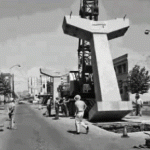The following downloads are worksheets designed to help plan aspects of a SharePoint 2010 or a SharePoint 2013 implementation, and at the same time ensure that decisions in the design are captured.So, you should use these in conjunction with the development of the following documents:
1: SharePoint User Requirements – these define SharePoint collaborative environments for the users based on their requirements, and provides a fundamental understanding of interconnected tools and applications the organization uses in conjunction with the platform. SharePoint User Requirements also identify where content should be consolidated, reduce and improve data management; reduce duplication and boost productivity as defined by the clients’ vision of SharePoint.
2: SharePoint System Specification (also known as SharePoint Solution Specification) – expands the User Requirements, Planning and Decisions concerning SharePoint as technical requirements. The system specification is a clear, complete and unambiguous set of documentation, describing the SharePoint for the organization in terms of its function, performance, interfaces and design constraints.
The below is divided as follows:
- Area – Specific SharePoint area
- Link – where the document can be downloaded from
- Type – the kind of information captured and which document is more associated with its output. UR = User Requirements, SS = System Specifications
Where it helps – describes the context and areas of SharePoint design gathering these documents can be used. Note that I have also indicated whether the worksheet is for SharePoint 2010 or SharePoint 2013.
| Area | Link | Plan Type | Where it helps |
| Backup and Recovery | http://go.microsoft.com/fwlink/?LinkID=184385 | Planning SS | SharePoint 2010. Help you plan strategies for backup and recovery. |
| Content deployment | http://go.microsoft.com/fwlink/?LinkID=167835 | Content Deployment SS | SharePoint 2010 / 2013. .Plan the export and import servers in the farms in your content deployment topology, and to plan the content deployment paths and jobs. |
| Document management | http://go.microsoft.com/fwlink/?LinkID=165871 | Stakeholders UR | SharePoint 2010 / 2013. .Identify document management planning stakeholders and record document management practices. |
| Document management | http://go.microsoft.com/fwlink/?LinkID=165873 | Usage UR | SharePoint 2010 / 2013. Record information gathered when analyzing document usage. |
| Document management | http://go.microsoft.com/fwlink/?LinkID=165874 | Document Libraries UR | SharePoint 2010 / 2013. Plan libraries based on sites and on document types. |
| Document management | http://go.microsoft.com/fwlink/?LinkID=165883 | Policy UR | SharePoint 2010 / 2013. Plan information management policies for content types. |
| Managed metadata | http://go.microsoft.com/fwlink/?LinkId=163486 | Term Sets UR | SharePoint 2010 / 2013. Determine basic taxonomy, including term, usage, owner, and group. |
| Managed metadata | http://go.microsoft.com/fwlink/?LinkId=163487 | Term Sets UR | SharePoint 2010 / 2013. .Determine taxonomy including detailed identifying characteristics such as measurements. |
| Managed metadata | http://go.microsoft.com/fwlink/?LinkId=164578 | Managed Metadata Service UR / SS | SharePoint 2010 / 2013. .Plan to share metadata information using managed metadata services and connections. |
| Metadata-based routing and storage planning | http://go.microsoft.com/fwlink/?LinkId=189018&clcid=0x409 | Content Organizer Settings SS | SharePoint 2010 / 2013. .Determine and record how the content organizer settings in your site can be an effective part of your metadata-based content routing and storage solution. |
| Metadata-based routing and storage planning | http://go.microsoft.com/fwlink/?LinkId=189019&clcid=0x409 | Content Organizer Rule SS | SharePoint 2010 / 2013. .Plan rules that will be an effective part of your metadata-based routing and storage solution. |
| Prepare for upgrade | http://go.microsoft.com/fwlink/?LinkId=179928 | Upgrade SS | SharePoint 2010.Record information about your environment while you prepare for upgrade. |
| Records management | http://go.microsoft.com/fwlink/?LinkId=185011 | In Place Records UR | SharePoint 2010.Identify record types and content types to be stored in normal document libraries. |
| Sites and site collections, Navigation, Themes | http://go.microsoft.com/fwlink/?LinkID=167837 | Site UR / SS | SharePoint 2010.Plan top level site collections and sites, and record decisions about site themes and navigation. |
| Backup and Recovery | http://go.microsoft.com/fwlink/p/?LinkId=256660 | Planning SS | SharePoint 2013. Help you plan strategies for backup and recovery. |
| Service Deployment | http://go.microsoft.com/fwlink/p/?LinkId=256658 | Planning SS | SharePoint 2013: Plan for an indicate the services that will run on farm servers |
| Prepare for upgrade | http://go.microsoft.com/fwlink/p/LinkId=256659 | Upgrade SS | SharePoint 2010.Record information about your environment while you prepare for upgrade. |
| e-Discovery | http://go.microsoft.com/fwlink/p/LinkID=254840 | Usage: UR | SharePoint 2013: Record the decisions that you make as you plan to implement eDiscovery in your SharePoint environment, including decisions about eDiscovery Centers and permissions |
| http://go.microsoft.com/fwlink/p/?LinkId=267990 | Planning:SS | SharePoint 2013: Plan for incoming email for your SharePoint farm |
I’m going to add some more documents to aid gathering of information relevant to other areas of SharePoint user requirements and system specification. You should also take a look at my user requirements article – that can help you determine the format of those documents and how the above can link.







